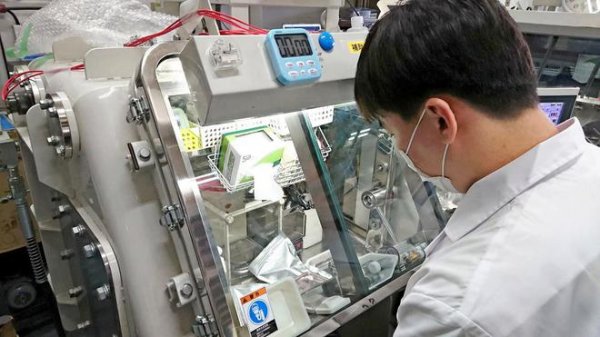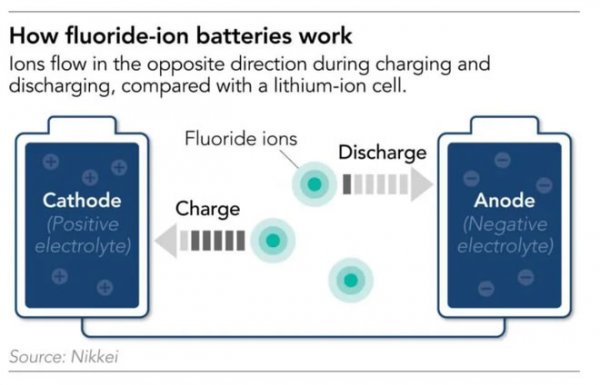According to the Nihon Keizai Shimbun, researchers from Toyota and Kyoto University are jointly developing a new generation of battery technology that has the potential to pack more energy than current standard lithium-ion batteries into a small, light-weight battery pack in.

The new fluorine-ion battery that the two parties are studying has about 7 times the energy per unit weight of traditional lithium-ion batteries, allowing electric vehicles to travel 1,000 kilometers on a single charge.
The team developed a prototype of a fluorine-based rechargeable battery. The fluoride ion battery (FIB) uses a fluoride ion conductive electrolyte to transfer fluoride ions from one electrode to another to generate electricity.
The anode or negatively charged electrode of this prototype is composed of fluorine, copper and cobalt, while the cathode or positively charged electrode is mainly composed of lanthanum. Researchers have confirmed that the battery prototype has a higher theoretical energy density, which may make its battery life 7 times longer than current lithium-ion batteries.
In recent years, due to improvements in lithium-ion battery performance and deceleration energy recovery systems, the cruising range of electric vehicles has increased significantly. The deceleration energy recovery system uses the electric energy generated by braking to charge the battery. For example, some of the latest electric cars from Tesla and Nissan can travel up to 600 kilometers per charge under ideal conditions. But experts said that the energy density of lithium-ion batteries is theoretically limited, which means that their range of cruising range cannot be further expanded.
Researchers at Kyoto University and Toyota have turned to fluorine ion batteries (FIB) because in theory it has a higher energy density. This means that smaller and lighter batteries have the same performance as lithium-ion batteries, or, if they are the same size and weight as current lithium-ion batteries, they can provide longer periods of power between charges.
Researchers use solid electrolytes to replace the liquid electrolytes commonly used in lithium-ion batteries. A key advantage of such solid-state batteries is that they will not catch fire, which means that engineers do not have to worry about creating systems that prevent overheating.
Researchers believe that solid-state FIB batteries can solve the problem of electric vehicles that can travel 1,000 kilometers on a single charge. However, many experts remain skeptical. The biggest challenge is that so far, FIB batteries can only work at high temperatures. In other words, when the solid electrolyte is sufficiently heated, fluoride ions will move to the polarized electrode. This makes FIB batteries unmatched for many consumer applications. The required high temperature can also cause the electrode to expand.
The Kyoto University and Toyota research teams say they have found a way to prevent electrode expansion by using an alloy of cobalt, nickel and copper to make electrodes. The team plans to adjust the materials used for the anode to ensure that the battery can be charged and discharged without losing capacity.
In 2018, scientists from the Honda Research Institute, California Institute of Technology and NASA’s Jet Propulsion Laboratory reached an important milestone through FIB battery technology: the ability to operate the battery at room temperature while It is not heating the battery to a high temperature.
In a paper published in the journal "Science", California Institute of Technology researcher co-author Robert Grubbs stated, "Fluorine batteries can have a higher energy density, which means they can be used for a longer period of time than those used today. The battery life is 8 times longer."

Other studies in Japan and overseas are also looking for alternatives to lithium-ion batteries. Magnesium ion and aluminum ion are one of the most promising candidates. But the competition for the development of such batteries is fierce. Yasuo Ishiguro, executive director of the Lithium-ion Battery Technology and Evaluation Center Alliance, a research institute in Osaka, said that whoever can develop the best performance rechargeable batteries can become a global leader in this key technology field.
The battery market is profitable, and global sales are expected to exceed 6 trillion yen (approximately US$56 billion) within three years. Advances in rechargeable battery technology will not only lead to better electric vehicles. This will make them a universal storage medium for solar and other renewable energy generation, helping to provide clean energy for society.
Although people's hopes for fluoride ion batteries are growing, they will not enter the market yet. Many experts believe that commercially viable fluoride ion batteries may not be commercialized until the 1930s. The prototype of the lithium ion battery was developed in 1985, but it was not commercialized until 1991.
Japan is not very good at chemistry and system integration required to maximize product performance, so the battle for supremacy in the battery field will be an uphill battle. The United States and China, which are in a leading position in artificial intelligence and next-generation computing technologies, will become formidable opponents in the battery competition.
To keep up with this trend, Japan also needs a strategy that combines mass production of batteries with market development. Around 2000, new competitors from China and South Korea seized market share through low-priced products, causing Japanese companies to lose their advantage in the global lithium battery market. Companies in all these countries are determined to gain a foothold in the battery market that will power the future.
Hand Pallet,Manual Pallet Jack,Hand Pallet Jack,Hydraulic Pallet Truck
Guangdong Gongyou Lift Slings Machinery CO.,LTD , https://www.gongyouslings.com